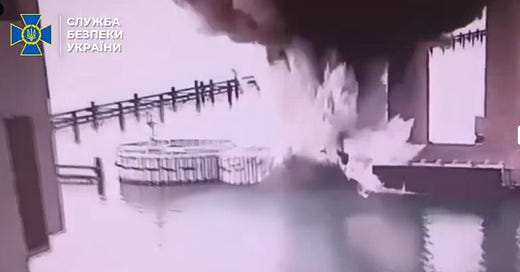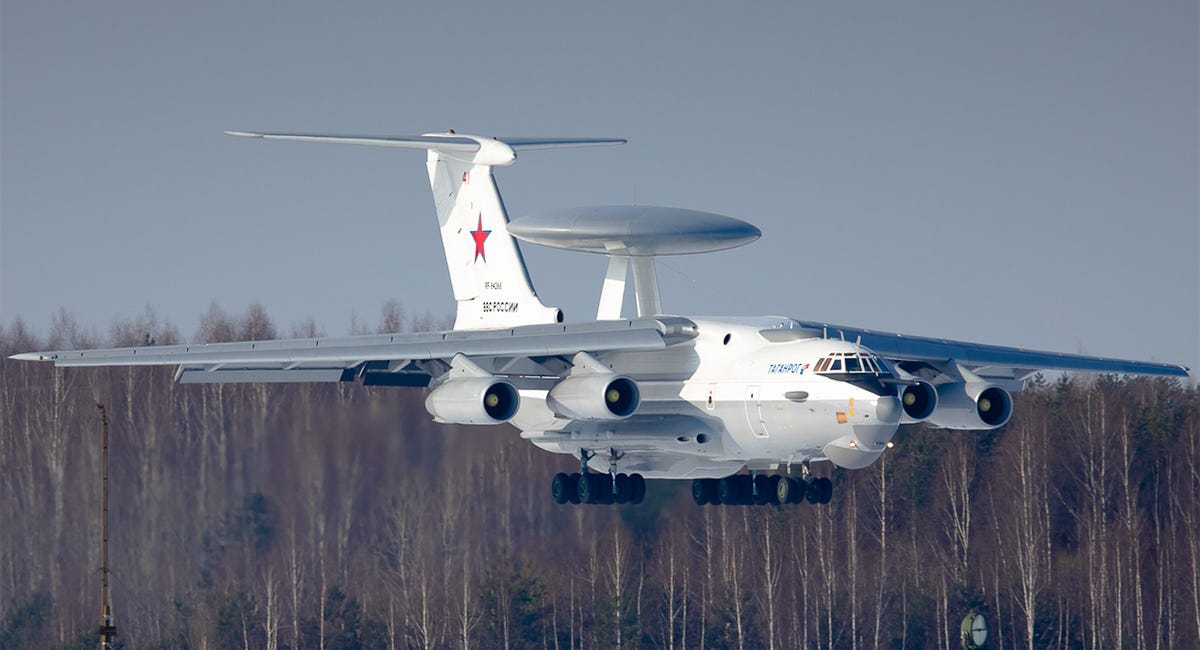Ukrainian Agents Just Blew Up a Pillar of the Strategic Kerch Bridge with a 2,400-Pound Underwater Bomb
The bridge is probably badly damaged, but it might not matter along the front line
Ukraine’s state security service, or SBU, has blown up one of the concrete pillars of the Kerch Bridge, which connects Russia to Russian-occupied Crimea across the Kerch Strait. The bomb weighed 2,400 pounds.
The powerful underwater blast, months in the planning, may have weakened the 11-mile bridge with its parallel spans for road and rail traffic. The seven-year-old bridge resumed operation a few hours after the strike on Tuesday, according to the BBC—but that doesn’t mean there isn’t lasting damage that could eventually throttle the flow of people, vehicles and supplies into southern Ukraine.
It might not matter. Ukrainian leaders are struggling to connect dramatic special operations such as the Kerch Bridge bombing—the third major attack on the bridge since Russia widened its war on Ukraine in February 2022—with military operations along the 700-mile front line.
It’s not a new problem. “Long-range strikes were an important piece of the puzzle, affecting how Russian forces operate, but by themselves were not decisive and could not solve the challenges observed on the modern battlefield,” Michael Kofman, a fellow with the Carnegie Endowment for International Peace in Washington D.C. explained after a recent visit to Ukraine.
Kofman’s comments appear in a study by Ukrainian analysis group Frontelligence Insight.
“Both sides struggled to overcome a prepared defense backed by mass precision,” Kofman observed. “Consequently, these [deep-strike] weapons had shaping effects on enemy forces, but Ukraine was often not in a position to capitalize on them.”
Lacking the forces to exploit whatever temporary shortages of men and materiel result from attacks on Russian bridges and other logistical infrastructure, Ukrainian commanders can only watch as strategic opportunities slip away. That has the effect of reducing some of the most dramatic Ukrainian special operations to mere spectacle.
Impactful special ops
The previous major SBU special operation was an exception to that rule. On Sunday, the SBU sneaked several long-haul trucks carrying containers full of short-range attack drones close to several Russian air force bases.
The service targeted Dyagilevo, Ivanovo, Olenya, Belaya and Ukrainka air bases—respectively 310, 470, 1,200, 2,700 and 3,700 miles from Ukraine—with more than 100 explosive quadcopters connected to their operators via Russia’s telecommunications network.
The drones meant for Ukrainka never launched. It’s unclear whether the attack on Dyagilevo succeeded, but signs point to no. However, we have video of the attacks on Olenya and Belaya, as well as post-strike imagery of Belaya and Ivanovo—and it seems all three bases were hit.
The SBU claimed it damaged as many as 40 Russian planes, in all. So far, it’s possible to confirm hits on seven Tupolev Tu-95 bombers, four Tupolev Tu-22M bombers and a single Antonov An-12 transport. Two journalists claimed to have seen video, not yet released, of hits on a pair of Beriev A-50 radar planes at Ivanovo.
If the video is real, the toll from Sunday’s raids could exceed 14 large warplanes—including at least 11 bombers out of a pre-raid bomber fleet numbering at most 118.
The A-50 losses could be the most impactful, as the Russian air force has just a handful of the planes—and needs nine to maintain constant radar coverage over the front line in Ukraine. The SBU drone op could open yawning gaps in Russian sensor coverage that could make further Ukrainian strikes easier.
The real reason for the success of the Sunday op, strategically speaking, is that it doesn’t depend on follow-on actions by Ukrainian ground forces to have a material effect on the war.
Eliminating hard-to-replace—if not impossible-to-replace—bombers and radar planes reduces the scale and intensity of attacks on Ukrainian cities and facilitates the escalating Ukrainian drone campaign targeting bases, factories and refineries inside Russia.
Damaging a bridge, on the other hand, could fray the supply lines to Russian forces in southern Ukraine. But who cares when Ukrainian forces in the south lack the capacity for offensive action?
Read more:
Ukraine's Smuggled Drone Raid May Have Blown Up One of Russia's Last Few A-50 Radar Planes
The Russian air force began Russia’s wider war on Ukraine in February 2022 with nine active Beriev A-50sM/Us—four-engine Ilyushin Il-76 airlifters with radar radomes on their fuselages and stations for up to 15 crew and battle-managers.






